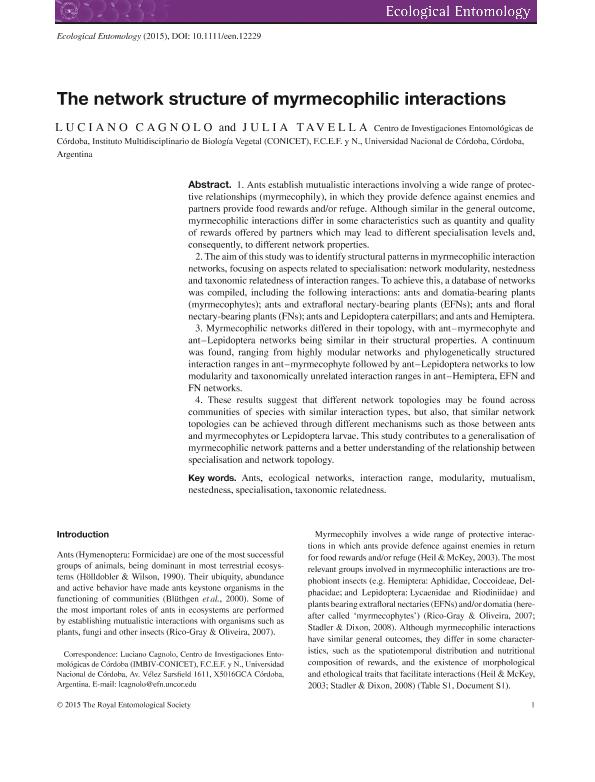Mostrar el registro sencillo del ítem
dc.contributor.author
Cagnolo, Luciano

dc.contributor.author
Tavella, Julia Rita

dc.date.available
2017-04-27T21:38:58Z
dc.date.issued
2015-10
dc.identifier.citation
Cagnolo, Luciano; Tavella, Julia Rita; The network structure of myrmecophilic interactions; Wiley; Ecological Entomology; 40; 5; 10-2015; 553-561
dc.identifier.uri
http://hdl.handle.net/11336/15818
dc.description.abstract
1. Ants establish mutualistic interactions involving a wide range of protective relationships (myrmecophily), in which they provide defence against enemies and partners provide food rewards and/or refuge. Although similar in the general outcome, myrmecophilic interactions differ in some characteristics such as quantity and quality of rewards offered by partners which may lead to different specialisation levels and, consequently, to different network properties.
2. The aim of this study was to identify structural patterns in myrmecophilic interaction networks, focusing on aspects related to specialisation: network modularity, nestedness and taxonomic relatedness of interaction ranges. To achieve this, a database of networks was compiled, including the following interactions: ants and domatia-bearing plants (myrmecophytes); ants and extrafloral nectary-bearing plants (EFNs); ants and floral nectary-bearing plants (FNs); ants and Lepidoptera caterpillars; and ants and Hemiptera.
3. Myrmecophilic networks differed in their topology, with ant–myrmecophyte and ant–Lepidoptera networks being similar in their structural properties. A continuum was found, ranging from highly modular networks and phylogenetically structured interaction ranges in ant–myrmecophyte followed by ant–Lepidoptera networks to low modularity and taxonomically unrelated interaction ranges in ant–Hemiptera, EFN and FN networks.
4. These results suggest that different network topologies may be found across communities of species with similar interaction types, but also, that similar network topologies can be achieved through different mechanisms such as those between ants and myrmecophytes or Lepidoptera larvae. This study contributes to a generalisation of myrmecophilic network patterns and a better understanding of the relationship between specialisation and network topology.
dc.format
application/pdf
dc.language.iso
eng
dc.publisher
Wiley

dc.rights
info:eu-repo/semantics/openAccess
dc.rights.uri
https://creativecommons.org/licenses/by-nc-sa/2.5/ar/
dc.subject
Ants
dc.subject
Ecological Networks
dc.subject
Interaction Range
dc.subject
Modularity
dc.subject.classification
Ecología

dc.subject.classification
Ciencias Biológicas

dc.subject.classification
CIENCIAS NATURALES Y EXACTAS

dc.title
The network structure of myrmecophilic interactions
dc.type
info:eu-repo/semantics/article
dc.type
info:ar-repo/semantics/artículo
dc.type
info:eu-repo/semantics/publishedVersion
dc.date.updated
2017-04-26T18:38:48Z
dc.identifier.eissn
1365-2311
dc.journal.volume
40
dc.journal.number
5
dc.journal.pagination
553-561
dc.journal.pais
Estados Unidos

dc.journal.ciudad
Hoboken
dc.description.fil
Fil: Cagnolo, Luciano. Consejo Nacional de Investigaciones Científicas y Técnicas. Centro Científico Tecnológico Conicet - Córdoba. Instituto Multidisciplinario de Biología Vegetal. Universidad Nacional de Córdoba. Facultad de Ciencias Exactas Físicas y Naturales. Instituto Multidisciplinario de Biología Vegetal; Argentina
dc.description.fil
Fil: Tavella, Julia Rita. Consejo Nacional de Investigaciones Científicas y Técnicas. Centro Científico Tecnológico Conicet - Córdoba. Instituto Multidisciplinario de Biología Vegetal. Universidad Nacional de Córdoba. Facultad de Ciencias Exactas Físicas y Naturales. Instituto Multidisciplinario de Biología Vegetal; Argentina
dc.journal.title
Ecological Entomology

dc.relation.alternativeid
info:eu-repo/semantics/altIdentifier/url/http://onlinelibrary.wiley.com/doi/10.1111/een.12229/abstract
dc.relation.alternativeid
info:eu-repo/semantics/altIdentifier/doi/http://dx.doi.org/10.1111/een.12229
Archivos asociados
